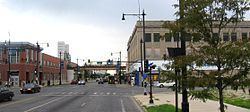Country United States Time zone CST (UTC-6) Asian population 0.1% Black population 97.4% Area code Area code 773 | Area 8 km² Hispanic population 1.1% Population 30,654 (2010) | |
 | ||
Neighborhoods listEnglewoodHamilton Park Restaurants Sikia, Island Fish & Chicken, Brothers Submarine, Georgia's food depot, Long Tung Chinese Restaurant | ||
Driving through englewood chicago
Englewood is one of the 77 official community areas in Chicago, Illinois, United States. At its peak population in 1960, over 97,000 people lived in its approximately 3 square miles (7.8 km2), but the neighborhood's population has since dropped dramatically. In 2000, it had a population of approximately 40,000 inhabitants, and the 2010 census indicated that its population has further declined to approximately 30,000. Englewood is bordered by Garfield Boulevard to the north, 75th Street to the south, Western Avenue to the west, and State Street to the east. It is located on the southwest side of Chicago.
Contents
- Driving through englewood chicago
- Map of Englewood Chicago IL USA
- History
- Demographics
- Transportation
- Socioeconomics
- Education
- In popular culture
- Notable residents
- References
Map of Englewood, Chicago, IL, USA
History
Before the city of Chicago was established, the area that is now Englewood was largely swampland inhabited by Mascouten Indians. In 1839, the US Government Land Office of Chicago stated that the land was habitable. In the 1850s and 1860s, as Chicago was becoming a city of railroad tracks and economic prosperity, Englewood was just another supporting neighborhood. But in 1871, when the Great Chicago Fire destroyed a large portion of Chicago, residents moved to the outskirts such as Englewood. Englewood's railroad connections to downtown Chicago made it a convenient location, and the neighborhood's population grew rapidly. Englewood Station once served many railroad passengers; in 1889, over 1,000 trains would pass through Englewood every day.
Englewood was the home of Dr. H. H. Holmes, one of the first publicized serial murderers in America. His hotel at Wallace and 63rd streets was the scene of most of his crimes and earned it the sobriquet "Murder Castle".
The Englewood community was largely defined by the Englewood Shopping Center at 63rd & Halsted, a large pedestrian mall. The City, social services, and mall management worked with community leaders and groups to integrate the mall with the community. The goal was to make the mall a vital part of the community, and a central part of everyday life. It was the site of numerous community events, parades, outdoor concerts, live radio broadcasts and the like. This was spearheaded by the Englewood Business Men's Association and its director, Richard Drew. Mr. Drew died in 1978, and with his passing the Association lost its community focus. The Center subsequently lost its major anchor tenants, including Sears Roebuck, and became a collection of smaller merchants.
In 1999, Mayor Richard M. Daley announced a $256 million revitalization plan for the area. The keystone of the program is the relocation of Kennedy-King College to the former site of the Englewood Shopping Center. Shortly thereafter the city began an aggressive buyout and relocation program for mall merchants. The campus includes the Washburne Culinary Institute. Groundbreaking for the new, 40-acre (160,000 m2) campus occurred on November 9, 2005, and it opened in 2007.
Digital images of Englewood can be found in Explore Chicago Collections, a digital repository made available by Chicago Collections archives, libraries and other cultural institutions in the city.
Demographics
In 1960 Englewood had 67,216 black people and 51,583 white people; black people made up about 69% of the residents in Englewood. At the time most black people resided around 63rd Street. At the time the median income of Englewood was $5,579 ($45,165.43 according to inflation).
By 1980 the total population was 62,069, a loss of about 30,000 people in two decades; 99% of the people were black, and the white population was down to 818. Edward McClelland of NBC Chicago stated "Not even ethnic cleansing in the Balkans achieved the levels of turnover that white flight in Chicago did."
Transportation
Both the Chicago Transit Authority's Red Line and Green Line run through Englewood, as does the Dan Ryan Expressway (I-90 and I-94).
The railroad junction at Englewood, where Metra (the former Rock Island) crosses Norfolk Southern (the former Pennsylvania) has long been a cause of delay. In March 2010 a $133 million reconstruction project was announced which improved operations by replacing the diamond crossing between Metra and NS with an overpass for Metra. The project was completed in 2014.
Socioeconomics
In 2000, Englewood had a poverty rate of 44%, which was substantially higher than the overall poverty rate in Chicago of 20%.
Based on census data collected by the city of Chicago in 2008-2012, the poverty rate for Englewood is 46.6% of households below poverty and 28% of people 16 years of age and older are unemployed.
Education
Chicago Public Schools operates public schools in the neighborhood.
Englewood is home to Johnson College Prep, a Noble Network charter high school. Team Englewood Community Academy and Urban Prep Academies Englewood Campus is operated in the Englewood High School building. Englewood High School was opened in 1873, but closed due to poor performance in 2008.
